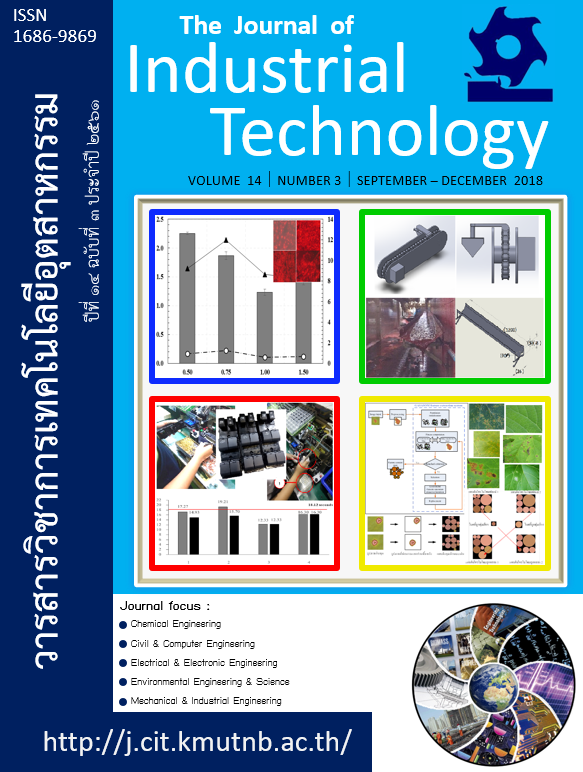(การวินิจฉัยจำแนกโรคใบองุ่นจากภาพถ่ายโดยใช้จีเนติกอัลกอริทึม และแผนผังจัดการตนเองเชิงโครงสร้างปรับตัวได้) (Imagery Grape Leaf Disease Diagnosis Based on a GA-SASOM Algorithm)
Keywords:
Pattern classification, Genetic Algorithm, Disease diagnosis, Structure-adaptive self-organizing mapsAbstract
Agriculture industry is one of major industry in Thailand. Nowadays, agriculture industry uses more innovation for development, especially image processing technology and computer vision. One of important problem in agriculture industry is overdose on chemicals to handle plant diseases that cause many problems such as pollutions, health hazards and expensive cost. So, if we can initial plant disease diagnosis, we can reduce productivity damage and avoid overdose on chemicals. This research presents algorithm for grape leaf disease diagnosis from complex background imagery. The system consists genetic algorithm (GA) and structure-adaptive self-organizing maps (SASOM) called GA-SASOM algorithm, which we developed basic GA structure to be main structure of classification system with new chromosome type that developed from basic SASOM node map called chromosome map. This research used each chromosome map to represent each color characteristics and pattern class of leaf disease, which was feature extraction model of grape leaf disease image. This work was test grape leaf disease diagnosis system with 4 diseases include Scab, Rust, Downy mildew and Powdery mildew, which each image had various size, position, rotation and light condition. These system achieved a performance up to 94.35% of accuracy.
References
[2] H. Wang, Y. Feng, Y. Sa, J.Q. Lu, J. Ding, J. Zhang and X.H. Hu, “Pattern recognition and classification of two cancer cell lines by diffraction imaging at multiple pixel distances”, Pattern Recognition 61, 2017, pp.234-244.
[3] A. Alharbi and F. Tchier, “Using a genetic-fuzzy algorithm as a computer aided diagnosis tool on Saudi Arabian breast cancer database”, Mathematical Biosciences 286, 2017, pp. 39-48.
[4] C. Shanthi and N. Papa, “An artificial intelligence based improved classification of two-phase flow patterns with feature extracted from acquired images”, ISA Transactions 68, 2017, pp.425-432.
[5] H. Hu, Y. Liu, M. Liu and L. Nie, “Surface defect classification in large-scale strip steel image collection via hybrid chromosome genetic algorithm”, Neurocomputing 181, 2016, pp. 86-95.
[6] E. Alexandre, L. Cuadra, S. Salcedo-Sanz, A. Pastor-Sanchez and C. Casanova-Mateo, “Hybridizing Extreme Learning Machines and Genetic Algorithms to select acoustic features in vehicle classification applications”, Neurocomputing 152, 2015, pp. 58-68.
[7] D.Y. Eroglu and K. Kilic, “A novel Hybrid Genetic Local Search Algorithm for feature selection and weighting with an application in strategic decision making in innovation management”, Information Sciences 405, 2017, pp. 18-32.
[8] A. Meunkaewjinda, P. Kumsawat, K. Attakitmongcol and A. Srikaew, “Grape leaf disease detection from color imagery using hybrid intelligent system”, Proceedings of ECTI Conference, 2008, pp. 513-516.
[9] S. Zhang, X. Wu, Z. You and L. Zhang, “Leaf image based cucumber disease recognition using sparse representation classification”, Computers and Electronics in Agriculture, 2017, pp. 135-141.
[10] T. Rumpf, A.K. Mahlein, U. Steiner, E.C. Oerke, H.W. Dehne and L. Plumer, “Early detection and classification of crop diseases with support vector machines based on hyperspectral reflectance”, Computer Electronics Agriculture 74(1), 2010, pp. 91-94.
[11] D.A. Bashish, M. Braik and S. Bani-Ahmad, “Detection and classification of leaf diseases using K-means-based segmentation and neural networks based classification”, Information Technology Journal, 2011, pp. 267-275.
[12] S. Arivazhagan, R. NewlinShebiah, S. Ananthi and S. Varthini, “Detection of unhealthy region of plant leaves and classification of plant leaf diseases using texture features”, Agriculture Engineering International: CIGR Journal 15(1), 2013, pp. 211-217.
[13] S.W. Zhang, Y.J. Shang and L. Wang, “Plant disease recognition based on plant leaf image”, The Journal of Animal & Plant Sciences 25, 2015, pp. 42-45.
[14] H. Holland, “Adaptation in Natural and Artificial Systems”, Ann Arbor: the University of Michigan Press, Michigan, 1975.
[15] S. Li, H. Wu, D. Wan and J. Zhu, “An effective feature selection method for hyperspectral image classification based on genetic algorithm and support vector machine”, Knowledge-Based Systems 24, 2011, pp. 40-48.
[16] C.H. Lin, H.Y. Chen and Y.S. Wu, “Study of image retrieval and classification based on adaptive features using genetic algorithm feature selection”, Expert Systems with Applications 41, 2014, pp. 6611-6621.
[17] G. Nagarajan, R.I. Minu, B. Muthukumar, V. Vedanarayanan and S.D. Sundarsingh, “Hybrid Genetic Algorithm for Medical Image Feature Extraction and selection”, Procedia Computer Science 85, 2016, pp. 455-462.
[18] H. Hu, Y. Liu, M. Liu and L. Nie, “Surface defect classification in large-scale strip steel image collection via hybrid chromosome genetic algorithm”, Neurocomputing 181, 2016, pp. 86-95.
[19] E.K. Aydogan, I. Karaoglan and P.M. Pardalos, “hGA: Hybrid genetic algorithm in fuzzy rule-based classification systems for high-dimensional problems”, Applied Soft Computing 12, 2012, pp. 800-806.
[20] Z. Jian-Hua and L. Wei-Hua, “Intrusion detection based on improved SOM with optimized GA”, Journal of Computers 8(6), 2013, pp. 1456-1463.
[21] R.J. Kuo, K. Chang and S.Y. Chien, “Integration of self-organizing feature maps and genetic-algorithm-based clustering method for market segmentation”, Journal of Organizational Computing and Electronic Commerce 14, 2004, pp. 43-60.
[22] H.D. Jin, K.S. Leng, M.L. Wong and Z.B. Xu, “An efficient self-organizing map designed by genetic algorithms for the traveling salesman problem”, IEEE Transaction on Systems, Man and Cybernetics Part B 33(6), 2003, pp. 877-888.
[23] S.B. Cho, “Ensemble of structure-adaptive self-organizing maps for high performance classification”, Information Sciences 123, 2000, pp. 103-114.
[24] A. Meunkaewjinda, "Intelligence approach for grape leaf disease diagnosis system from color imagery”, Suranaree University of Technology. 2007. (in Thai).
[25] G. Stuart, N. Spruston, B. Sakmann and M. Hausser, “Action potential initiation and backpropagation in neurons of the mammalian CNS”, Trends in Neurosciences 20, 1997, pp. 125-131.
[26] N. Efford, “Digital Image Processing: A Practical Introduction Using Java”, Pearson Education, 2000.
[27] C. Hulett, A. Hall and G. Qu, “Dynamic selection of k nearest neighbors in instance-based learning”, Information Reuse and Integration, 2012, pp. 85-92.


